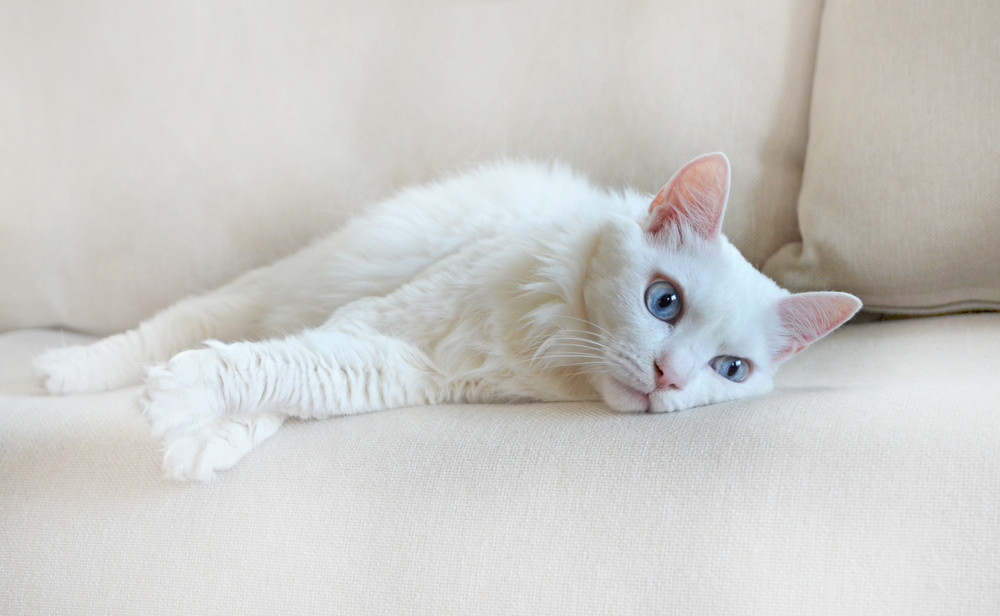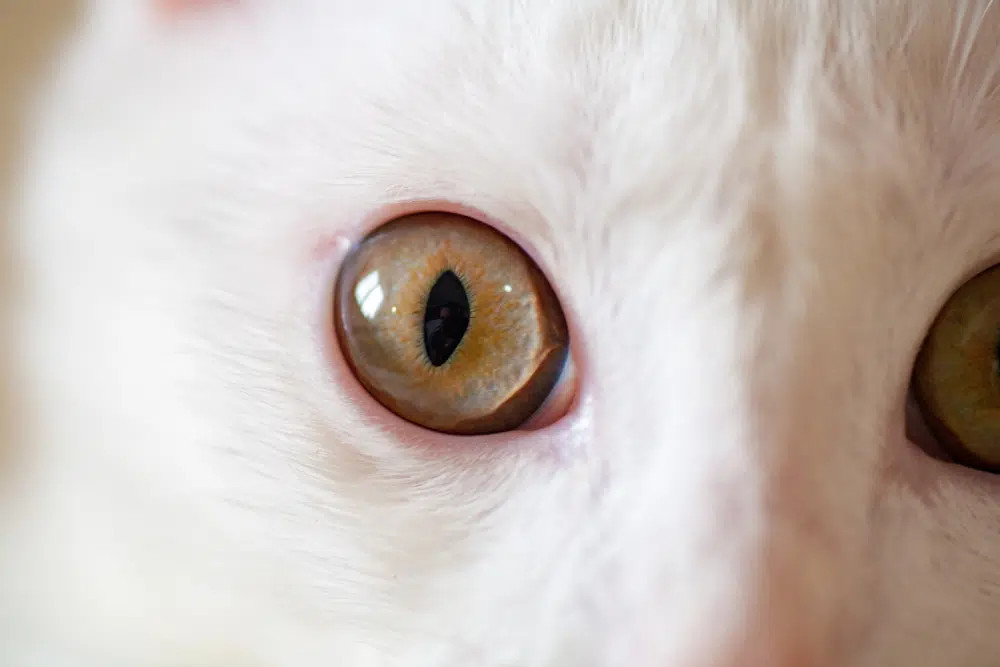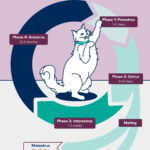Finding a cat with pristine white fur is often considered a stroke of luck, a rare and beautiful sight. But encountering a true albino cat? That’s an even rarer marvel. While all Albino Cats are white, not all white cats are albino. The distinction lies deep within their genetics, a fascinating difference that impacts their appearance, health, and care needs. If you’ve ever wondered about the unique charm of albino cats and how they differ from their white counterparts, you’re in the right place. Let’s delve into the world of these enchanting felines and uncover what truly sets them apart.
What Exactly is an Albino Cat? Decoding the Genetics of Albinism
An albino cat isn’t simply a white cat; it’s a feline born with albinism, a congenital condition characterized by a complete or partial absence of pigment in their skin, hair, and eyes. This lack of pigmentation stems from a genetic mutation affecting the tyrosinase (TYR) gene. These genes are the master architects behind melanin production, the pigment responsible for color in cats (and humans!). In albino cats, these genes malfunction, leading to a significant reduction or complete halt in melanin creation.
To inherit albinism, a kitten must receive a copy of this mutated gene from both parents. This “autosomal recessive” inheritance pattern means that if a cat only inherits the gene from one parent, they will be a carrier but not express albinism themselves. This genetic necessity contributes to the rarity of albino cats, making them truly special among the feline world. The result of this genetic quirk is a cat with snow-white fur, delicate pinkish skin, and strikingly pale blue or even pink-tinted eyes – features that define the albino phenotype.
 white albino cat laying on couch
white albino cat laying on couch
White Cat or Albino Cat? Spotting the Key Differences
While both albino cats and white cats boast a snowy coat, the similarities largely end there. The underlying genetic mechanisms that create their white fur are fundamentally different, leading to several distinguishing characteristics. Understanding these differences is crucial for proper care and appreciation of each type of feline.
Genetic Makeup: Mutation vs. Masking
The most significant difference lies in their genetic origins. As discussed, albinism in cats is caused by a recessive genetic mutation in the tyrosinase gene, hindering melanin production. White cats, on the other hand, typically owe their color to a dominant “W” gene. This gene acts as a “masking” agent, effectively overriding or concealing any other color or pattern genes the cat may possess. So, a white cat might genetically be a tabby, a tortoiseshell, or even a black cat underneath, but the dominant white gene ensures only white fur is expressed.
Eye Color: The Window to the Difference
Eye color provides another clear distinction. Albino cats, due to their lack of pigmentation, will invariably have eyes that appear pinkish or very pale blue. This pinkish hue is due to the visibility of blood vessels in the absence of pigment. In contrast, white cats exhibit a wide range of eye colors. They can have captivating blue eyes, mesmerizing green eyes, warm orange or yellow eyes, or even heterochromia – eyes of two different colors. This diversity in eye color is never seen in true albino cats.
Skin Tone: Pink vs. Pale
Skin color is yet another telltale sign. Albino cats have pink skin, a direct consequence of the lack of melanin. White cats, while pale, will still have a degree of pigmentation in their skin, resulting in a more flesh-toned or pale skin appearance, rather than the distinct pink of an albino. Gently checking the skin around their nose or ears can help discern this difference.
Health Predispositions: Beyond Appearance
Finally, the genetic differences extend to health predispositions. Albino cats, due to their lack of melanin, are more prone to certain health issues compared to white cats. Melanin plays a protective role against sun damage and contributes to immune system function, areas where albino cats may face challenges.
 divider 1 paws
divider 1 paws
Health Challenges Unique to Albino Cats: Understanding Potential Issues
The absence of melanin in albino cats, while responsible for their striking appearance, also makes them more vulnerable to specific health concerns. Understanding these potential issues is paramount for responsible albino cat ownership and ensuring their well-being.
Sun Sensitivity and Skin Damage
Melanin acts as a natural shield against the harmful effects of ultraviolet (UV) radiation from the sun. Albino cats, lacking this protective pigment, are highly susceptible to sunburn, skin cancer (especially squamous cell carcinoma), and other forms of sun-induced skin damage. Prolonged sun exposure can be extremely detrimental to their health. Therefore, keeping albino cats primarily indoors is crucial for their safety. If outdoor access is necessary, it should be strictly limited to shaded areas.
Light Sensitivity and Vision Problems
Beyond skin sensitivity, albino cats often exhibit heightened sensitivity to light in general, a condition known as photosensitivity. This is because melanin also plays a role in eye development and protection. Bright light can be uncomfortable and even painful for albino cats. They may squint or avoid brightly lit environments. Furthermore, albinism can be associated with nystagmus, involuntary rapid eye movements, which can lead to vision impairment and difficulties with depth perception. Regular veterinary eye exams are essential to monitor for and manage any vision-related issues.
Immune System Considerations
Melanin is not solely responsible for pigmentation; it also plays a role in the proper functioning of the immune system. While research is ongoing, some evidence suggests that the lack of melanin in albino cats may contribute to a slightly weakened immune system. This potential vulnerability could make them more susceptible to infections and illnesses compared to cats with normal pigmentation. Proactive preventative care, a balanced diet, and close monitoring for any signs of illness are important aspects of caring for an albino cat.
 white albino cat with yellow eyes close up
white albino cat with yellow eyes close up
Albino Cat Care: Tailoring Your Approach for Their Unique Needs
Caring for an albino cat requires a slightly adjusted approach compared to caring for a typical cat, primarily due to their increased sensitivity to sunlight and potential health predispositions. These adjustments are relatively simple to implement and contribute significantly to their health and happiness.
Prioritizing Indoor Living and Sun Protection
The cornerstone of albino cat care is minimizing their exposure to direct sunlight. Ideally, albino cats should live primarily indoors. This protects their sensitive skin and eyes from harmful UV radiation. If you wish to allow your albino cat outdoor time, ensure it is strictly limited to securely shaded areas, such as enclosed patios or cat-proofed gardens with ample natural shade. Avoid allowing them to bask in direct sunlight, especially during peak hours.
Regular Veterinary Check-ups and Proactive Health Monitoring
Due to their potential for increased health vulnerabilities, regular veterinary check-ups are even more crucial for albino cats. These check-ups should include thorough eye examinations to monitor for any vision problems or the development of nystagmus. Discuss any concerns about their immune system with your veterinarian and consider preventative measures like a high-quality diet and potentially immune-boosting supplements, as recommended by your vet. Promptly address any signs of illness or skin issues.
Supportive Care and Environmental Adjustments
Creating a comfortable and safe environment is also important. Provide plenty of shaded resting spots indoors. Consider using UV-protective window film in areas where your cat spends time near windows. Offer a balanced, nutrient-rich diet to support their overall health and immune system. Depending on your veterinarian’s recommendations, supplements like omega-3 fatty acids or antioxidants may be beneficial. Be observant of any signs of discomfort or light sensitivity and adjust their environment accordingly.
 divider 3 paws
divider 3 paws
Final Thoughts: Appreciating the Rare Beauty of Albino Cats
Albino cats are truly exceptional felines. While they may share the outward appearance of white fur with other cats, their albinism sets them apart as genetically unique individuals with specific needs and sensitivities. Understanding the differences between albino cats and white cats, recognizing their potential health challenges, and adapting their care accordingly allows us to fully appreciate these rare beauties and provide them with the happy, healthy lives they deserve. If you suspect your white cat might be albino, examining their skin and eye color can offer clues, but a veterinary confirmation can provide definitive answers and guide you in providing the best possible care for your special feline companion.
Related Reads:
Sources:
Featured Image Credit: Visionlabs, Shutterstock

